When I’m meeting with clients or prospective clients, I’m often asked how important it is to rank on page 1 of the search engines. It definitely is, and more on that topic in a minute. Then it’s typically not long before I’m asked how many keywords clients should rank for. That’s usually a longer conversation where I like to introduce the concept of the long tail (which I’ll be covering as part of this post).
I’ve written about the power of the long tail of SEO on my blog, including details for how to rank for long tail keywords, and my hope is that you’ll soon understand why I feel so strongly about it. In addition to discussing the importance of ranking highly in search and how powerful the long tail is, I often refer to the latest Google heat map study to reinforce my recommendations and to explain search behavior.
I find that if you start connecting the dots between high rankings, the latest heat map study, and the long tail of SEO, then organic search strategy becomes much clearer (especially for people outside of the Search industry). So, I ended up running an experiment recently and the results displayed a strong connection between the three elements I mentioned above. In fact, the results were so intriguing that I decided to write this post to detail my experiment! With that quick introduction out of the way, let’s get moving.
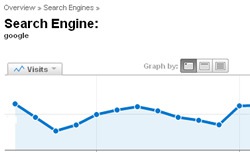 Organic Search and The Web Analytics Addiction
Organic Search and The Web Analytics Addiction
Like many of you reading this post, I’m fanatical about checking my web analytics reporting. I especially love digging into natural search reports and analyzing which keywords drove quality traffic to site, did those visitors bounce, where did they go on the site, did they convert, which type of keywords did they enter, did they use on-site search, etc.
My goal is to see how those visitors contributed to the overall success of the website that I’m analyzing. Several of the sites I manage use Google Analytics (GA) to track website activity and I’m definitely a big fan of GA. In early January, a blog post from Andre Scholten caught my attention. His post explained how to track where your keywords actually rank in Google within your Google Analytics reporting (on the fly). For example, seeing each keyword that led to your site, but also quickly seeing which page of Google it was listed on when people clicked through.
Keep in mind, I could use a number of tools to run a position analysis on target keywords, but that’s not feasible for long tail keywords, since you might be dealing with thousands of keywords at a time. In addition, you wouldn’t have ready access to deeper analytics reporting like you would in GA. So, I read Andre’s post and I quickly set up new profiles and custom filters for a number of websites that I manage. Needless to say, I was eager to see the results in Google Analytics.
It was only a few hours before I started seeing the results show up, and I picked up a trend pretty darn quickly. To be honest, it was a trend that I thought I would see, since I know the power of the long tail. That said, when you view it across a large number of keywords, and all at one time, it was definitely intriguing. Then as more and more keywords showed up, the trend simply got stronger.
Yes, It Is Important To Rank On Page 1, To Say The Least
I’ll cut to the chase. Almost every keyword I saw in the reporting ranked on page 1 of Google. I started scanning more keywords, clicking through additional pages of keywords, and an overwhelming amount ranked on page 1…
So I checked the other sites I used for this experiment and saw extremely similar results. I started manually checking keywords, head terms, torso, and long tail terms. It was incredible to scroll through the reporting and see page 1 rankings for almost all of the keywords. But here’s the rub, just because the final keywords that led to each site ranked on page 1, that didn’t mean it was the person’s first query…
That could have been their second, third, or fourth refinement. The long tail was absolutely in effect and was easily revealed. It clearly showed the importance and power of targeting long tail keywords and what that can mean for the volume of quality traffic. Sure, there were several head terms that ranked on page 1 of Google and those keywords did send a good amount of quality traffic to the sites I tested. But, there were terms that easily could have been the result of someone refining their query after not being happy with the search results.
For those of you unclear what a long tail keyword is, here is an example from my own blog:
how to use swfobject to provide alternative content for seo
— Sure, that could have been the person’s first query, but it also could have been their third or fourth, right? I don’t think many people in SEO often have a new client walk in and say they want to rank for a long tail keyword of that length! 😉 Which leads me to my next point, the long tail of SEO. Don’t worry, this will all connect by the end of my post.
The Powerful Long Tail of SEO
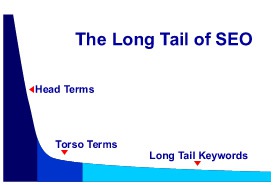 I think many people in Search understand the importance of ranking highly in Google, but I think too many people outside of Search are hung up on ranking for just a few target keywords. As mentioned earlier, I’ve written about the long tail of SEO on my blog, and it’s hard to overlook the power of the long tail when heavily analyzing search traffic across websites and verticals. I’m constantly talking about the long tail during client meetings, internal brainstorms, and to random people on the subway. Don’t worry, I’m in New York, so most people are used to this type of strange behavior. 🙂
I think many people in Search understand the importance of ranking highly in Google, but I think too many people outside of Search are hung up on ranking for just a few target keywords. As mentioned earlier, I’ve written about the long tail of SEO on my blog, and it’s hard to overlook the power of the long tail when heavily analyzing search traffic across websites and verticals. I’m constantly talking about the long tail during client meetings, internal brainstorms, and to random people on the subway. Don’t worry, I’m in New York, so most people are used to this type of strange behavior. 🙂
To quickly review, the long tail of SEO includes longer queries, typically including three or more keywords. These longer queries derive from your target keywords (or your head terms). For example, a head term might be Nintendo Wii, but a long tail keyword might be what are the best Nintendo Wii games. Although many people focus on head terms, the long tail might generate more quality visitors in aggregate (taking into account all long tail keywords versus just head terms). Anyone tracking SEO for a living has probably seen the impact of the long tail.
How Does the Long Tail Manifest Itself? Check the Latest Google Heat Map Study
OK, so we’re getting closer to the connection I mentioned earlier in this post. Stick with me! There’s one more element I need to explain before we get there. I’m sure many of you have seen or heard about Google heat map studies. One recent study from Think Eyetracking (September 2008) revealed that people are now scanning the first few results on page 1 of the SERPs, and if they don’t find what they need, they are refining their searches.
Think about someone searching for nike sneakers, then nike running sneakers, then men’s nike running sneakers, and finally men’s nike trail running sneakers. That person would have refined their initial search three times before clicking a result. The results from this study also match what Google recently released when studying Universal Search. So the important question is, do you have content that can rank for long tail keywords? For many websites and businesses, the answer is NO. That’s unfortunate, since long tail keywords are much more granular and specific (and can yield highly targeted visitors).
Comparing the 2008 and 2005 Google Heat Map Studies:
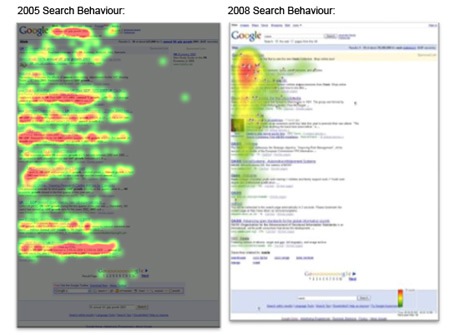
Source: Think Eyetracking, September 2008
Tying It All Together, The Results From My Ad Hoc Experiment:
As mentioned earlier, I set up new profiles and custom filters so I could track the position in Google for keywords leading to several sites that I manage. The sites I chose to test have varying search strength and focus on different verticals. The custom filter showed me which page each keyword was listed on when visitors clicked through by displaying the number of the first result on that page. For example, (Page: ), (Page: 10), (Page: 20), (Page: 30), where (Page: ) means page 1 in Google, (Page: 10) means page 2, (Page: 20) means page 3, etc. See the screenshot below for how it looks in Google Analytics (with my notes in dark blue).
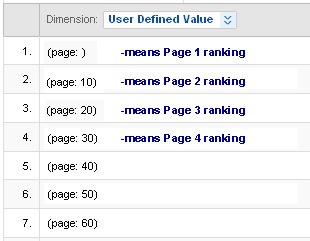
Quick Disclaimer Before Revealing the Results: Although this was not a scientific experiment, the results across various websites I tested were overwhelming. Based on seeing the results, I also started checking other sites I manage that weren’t initially part of the experiment, and saw the same trends across a large number of keywords. I will provide the results from my experiment below, along with how each type of keyword performed (head or long tail).
I analyzed over 3000 keywords across several websites I manage. Here are the results:
Percent of Keywords Driving Traffic That Ranked on Page 1 of Google
- 92% of the keywords that led to the websites I used in this experiment ranked on page 1 of Google.
- 6% ranked on page 2
- 1% ranked on page 3
- 1% ranked beyond page 3
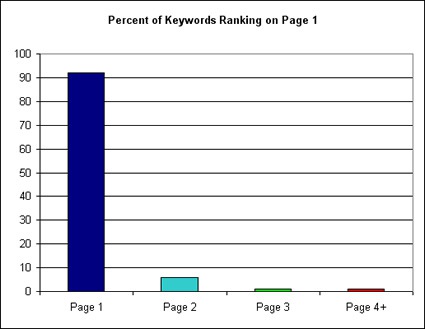
Total Number of Head Terms Versus Long Tail Keywords
7% of the total keywords were head terms and 93% were long tail keywords.
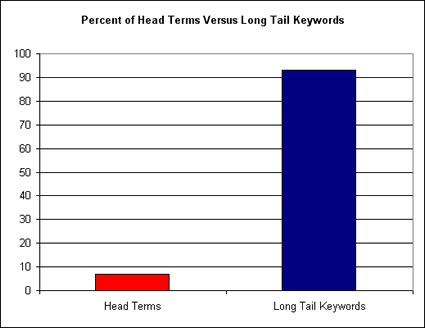
Percent of Traffic From Head Keywords vs. Long Tail
Traffic-wise, long tail keywords comprised 78% of visitors from organic search and head terms drove 22% of visitors.
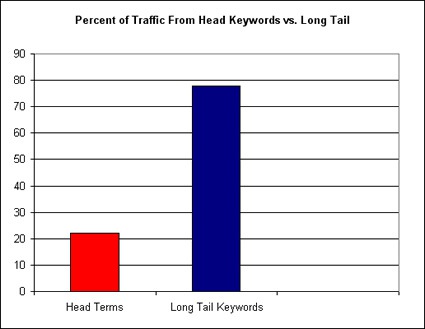
To quickly summarize the results:
- Ranking on page 1 of Google is extremely important, with 92% of the keywords driving traffic to the sites I tested, ranking on page 1.
- Based on the latest Google heat map study, people are scanning the first few results on page 1 and refining their searches (using longer tail keywords). This is represented by the total number of head terms versus long tail keywords (93% of keywords being long tail.)
- The percent of traffic from long tail keywords far outweighs the number of visitors from head terms.
Search Behavior Revealed and What This Means for You
Setting up this handy filter in Google Analytics enabled me to easily see the impact of high rankings along with the power of the long tail. By the way, you should also set up this filter so you can easily analyze the rankings of all your keywords on the fly… You can still use various search tools to run a position analysis on your head terms, but this filter enables you to see rankings across all of the keywords leading to your website.
So What Does This Mean For You As A Search Marketer?
Well, don’t just target head terms! Perform extensive keyword research, analyze your competition, speak with customers, understand what people are searching for, and always keep the long tail in mind. For example, ensure your website ranks highly when people refine their searches. You don’t just have to rank for a highly competitive head term to yield quality visitors that can impact your bottom line. Knowing this, you’re next logical question might be, “So how do I target the long tail?”
There are so many ways to create compelling content that targets the long tail that I can’t cover them in detail here (this post is already getting too long!) It’s why I often refer to SEO as the multi-channel channel. You can write blog posts, create how-to videos, conduct studies and surveys, write whitepapers, create tutorials, build tools and functionality, etc. The list goes on…
Yes, it definitely took a while, but I told you I would tie this together at some point! For those of you that have benefited from the power of the long tail (or have been knocked over by it), please chime in! I’d love to hear your thoughts.
Glenn Gabe is an online marketing consultant at G-Squared Interactive. He currently helps clients maximize their digital marketing efforts via SEO, SEM, Social Media, Viral Marketing and Web Analytics. You can read more of Glenn’s posts on his blog, The Internet Marketing Driver and you can follow him on Twitter to keep up with his latest projects, news, and updates.




